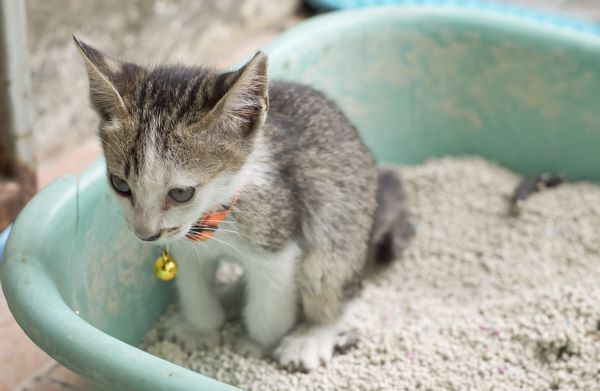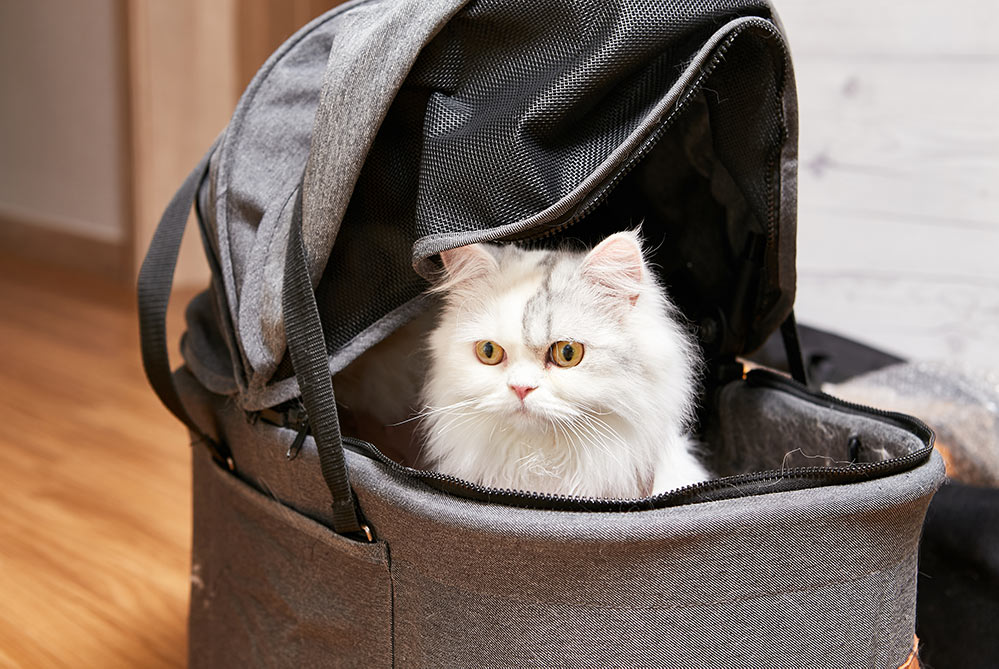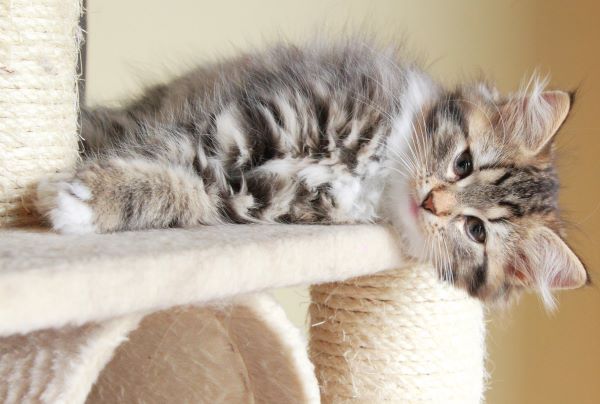Bringing a new kitten home: Tips & advice for new cat owners
Bringing your new kitten home is a very exciting experience, although there is often lots to consider and prepare before the big day when you actually get to pick her up.

When you arrive home for the first time with your new kitten, you’ll need plenty of patience to best help her gently settle into her new life. Cats are often stressed by a change of environment, so whether you are bringing home a kitten or you’re adopting an older cat, it can take a few weeks for you, kitty, and the rest of the household to feel relaxed and comfortable in each other’s presence. Knowing what to expect when bringing a new cat home will greatly facilitate this transition.
Read on for our top tips and advice about the following important topics:
Preparations before bringing a new kitten home
Items you’ll need for your new kitten
Fostering a bond with your new kitten
Bringing home strays or rescue kittens
Introducing your new kitten to your family
Preparations before bringing a new kitten home
 It’s important to know in advance what taking care of your new cat will entail, particularly if you’ve never owned a cat before. Before you bring him home, you will need to purchase all the essentials he needs for his first day and night. In the next section you’ll find a “bringing kitten home checklist” of the items your new kitten requires. You’ll also need some time to get your home ready and to prepare your kitten’s new living space. Here are some suggestions how to make it safe, cosy and comfortable for him.
It’s important to know in advance what taking care of your new cat will entail, particularly if you’ve never owned a cat before. Before you bring him home, you will need to purchase all the essentials he needs for his first day and night. In the next section you’ll find a “bringing kitten home checklist” of the items your new kitten requires. You’ll also need some time to get your home ready and to prepare your kitten’s new living space. Here are some suggestions how to make it safe, cosy and comfortable for him.
Conduct a home inspection
- An inspection of your house to assess potential dangers is essential before bringing your kitten home. Certain plants, chemicals and other items which are toxic to cats should be removed from the house or securely stored away. Be sure to read our article The most dangerous things cats ingest for more information on other common household dangers.
- You should also inspect all screens and windows to make sure they are secure, and that your cat won’t be able to escape through them.
- Cats like to hide in small dark spaces when they’re scared, so it’s best to block off small spaces to prevent your kitten from getting trapped in them.
Prepare your cat’s living space

It’s recommended to gradually introduce a new cat to your home, starting ideally with just one small, quiet, uninhabited room, away from noise and foot traffic. She should remain in this cosy space of their own for as long as it takes her to adapt to her new environment. This is because providing too much space initially can be overwhelming and even frightening for a new kitten.
Before bringing her home, determine where this initial living space will be; preferably a spare bedroom, the laundry room, or if there isn’t a dedicated room she can use, a blocked off space in the corner of your living room. Set up this room or space with a cat bed, litter tray and a small amount of food and water, positioned as far away as possible from the litter tray. Remove anything breakable of potentially harmful from the space, such as wires that could be chewed.
Acquire a familiar scent
Cats are heavily reliant on their sense of smell and will settle much quicker if their new environment smells familiar. There are a few ways you can obtain a familiar scent to assist with the transition, if you plan ahead:
- When arranging to pick up your new kitten, ask their current carer if you can also take home an item of bedding that is imbued with some familiar smells.

- Or, bring a towel or blanket with you and, with permission, rub it gently on your new kitten’s family members or along the inside of their sleeping area, so that it absorbs some of these familiar scents.
- Or, help your new kitty become familiar with your scent (and the scent of his soon-to-be new home) by taking an unwashed item of your clothing or a towel or a blanket from your home and leaving it with him for the final few days before you take him home.
Items you’ll need for your new kitten
Essential items you’ll need for the first day and night:
- One food bowl
- One water bowl
- Food and water
- A soft, warm and comfortable bed
- A litter tray
- A cat carrier
Other useful items for your new kitten:
- A brush
- Cat toys
- Something to climb up (a sturdy shelf or cat perch)
- A sturdy scratching post
- A place to hide (a cardboard box can do the trick)
- A kitten pen
- Cat pheromones can help some kittens feel calm and adjust to new surroundings more quickly (ask your vet for more advice).
Food, water and bowls

Your new kitten will need separate food and water bowls. Plastic bowls are not ideal as they are light and can tip over easily, so heavier china, pottery or porcelain bowls are preferable. It is important to keep the bowls clean and the contents fresh, as cats may reject old food or stale water.
If possible, find out from the breeder, adoption centre or previous owner what brand or type of food your cat has become accustomed to, and continue with it for at least the settling in period. It’s advisable to speak to your vet before embarking on a change of brand or type of cat food and making any changes very gradually. Any sudden change of diet can cause an upset tummy.
Place your kitten’s food and water bowls away from each other, while keeping both as far away from the litter tray as possible. Provide only small amounts of food at a time for the first 12 to 24 hours. Make sure fresh water is always available.
The litter tray
Your cat must have access to a litter tray, and most cats will instinctively use it. Many cats prefer simple litter trays without hoods and unscented, fine-textured litter. If possible, duplicate the type of tray and litter material used in the previous environment. Young kittens and elderly cats suffering from arthritis will need a tray with sides that are low enough for them to enter easily.

Once he’s used the litter tray for the first time, it’s a good idea to leave this droppings in it for the first 24 hours, as this will help him recognise where to continue toileting in the future. Thereafter, be sure to keep the litter tray clean and to change the litter frequently, because cats may avoid a litter tray that isn’t clean. See our articles Toilet training your new kitten or cat and Litter tray aversion in cats for more info on this topic.
A cosy bed
Whether it’s a simple cardboard box with cut down sides containing soft, warm blankets that your kitten can hide away in, or a fancy faux fur cat bed, most soft bedding will do nicely. The important thing is that your new kitten has a warm, cosy place to sleep, positioned somewhere quiet and safe – after all, kittens can sleep between 15 to 18 hours a day. Try to make the bed as snug as possible, because cats love to curl up in snug places. If the weather is cold, put a hot water bottle under the blankets.

Remember to place that familiar piece of their bedding that you brought home with you in her new bed and don’t throw it out or wash it during the first few days. It is embedded with the cat’s scent and will feel and smell familiar, thereby reassuring and comforting him.
A cat carrier
This is essential for trips to the vet and of course for bringing your new cat home. There are lots of different designs, but the most important thing is to choose one that is secure, well ventilated and sturdy and is easy to get the cat in and out of. A lid on the top will be very helpful for this purpose.

Bringing your new kitten home
Travelling home
Allocate plenty of time for collecting and bringing your new kitten home, so that the entire process is calm and unrushed. Your new kitty needs to feel comfortable with you as soon as possible, so start your relationship by interacting with him in his familiar environment where he feels safe and secure. Spend some time playing with and cuddling him before taking him away.
Make sure you take a cat carrier or basket when bringing your new kitten home and do not leave him loose in the car. Cats prefer cosy spots, so they often enjoy being in a carrier. By transporting your kitten in a carrier, you are providing safety and security, as well as starting a good routine for future car rides. Remember to place the familiar-smelling bedding or clothing item in the carrier with him; it’ll reduce stress during the journey and help him settle in once he arrives home.
Arriving home for the first time
 A new home with new sights, sounds, and smells can be a scary place for a young kitten, but you can help to make her adaptation easier. The first few hours after bringing a kitten home can influence how she’ll adapt to her new life. As excited as you and your family may be to welcome her, don’t rush her; prepare to be patient and don’t pressure her into doing things she may not yet be ready for.
A new home with new sights, sounds, and smells can be a scary place for a young kitten, but you can help to make her adaptation easier. The first few hours after bringing a kitten home can influence how she’ll adapt to her new life. As excited as you and your family may be to welcome her, don’t rush her; prepare to be patient and don’t pressure her into doing things she may not yet be ready for.
Once you arrive home, place the carrier on the floor in her allocated room, close the door, then open the carrier door and allow your kitten to come out in her own time. When she emerges, let her move around the room as she wishes, giving her time (at least an hour, but some cats need longer) to investigate and explore her new space before introducing yourself and/or your family.
If she chooses to hide, sit quietly on the floor at her level and talk to her gently. When cats are frightened it is normal for them to hide, so don’t get upset or try to force her to come out. Observe how she is acting – if she seems very scared, leave her alone for a few hours and let her take time to adjust. Pop in every few hours to check on her and talk to her in a calm and friendly voice. If she is eating, drinking and using the litter tray, there is no need to worry. If she is too scared or shy to eat, try moving her food bowl closer to her hiding place and leave the room. Hold off on the introductions to other family members – if you have young children, let them know the cat isn’t used to your house yet and will need some time to settle in.

Give your kitten plenty of time to become familiar with her room before exposing her to the rest of the house. Spend time in the room with her every day so that she gets used to your presence, talking to her, reading aloud or even making phone calls so that she becomes comfortable with your voice. Try to avoid loud or sudden noises in the house as these may scare her. When she seems to be more confident, relaxed and ready to explore, take it slowly and let her gradually discover her new surroundings one room at a time, always staying with her when you bring her to another room.
Tips and advice for the first night
The first night in a new home can be challenging for owners as well as the new cat or kitten, so try to make it as stress-free as possible. When it’s time to go to bed, leave him in the small room or enclosed area of the house that you have designated for him, in his cosy bed. Make sure he has the piece of bedding or scented item brought from his previous home, as the familiar scent will help him feel more secure.
It’s a huge change for him, so cries for attention are normal, even for the first few nights. Resist the temptation of taking him into your bed, as he may have accidents during the night. Some tips to comfort him during the first night (or two) include:
- Warm up a blanket (you can put it in the tumble drier or place a hot water bottle underneath it) to mimic the warmth he would get from his mum.
- Raise his bed up off the floor (if you have a low table or other platform that it can securely rest on) as kittens tend to feel safer at a height.
- The carrier can be a comforting place if your kitten is frightened or wants to ‘hide’ – place it near his bed with its door open so he can go in and out at any time.
- Leave a low night light on in his room while he is getting used to his new environment.
- If you prefer to have him close to you, place his bed on the floor or on a platform next to your bed.
Fostering a bond with your new kitten

Over the first few days, let your new cat get to know you by spending some time in his room each day. Don’t rush her, rather let her come to you when she’s ready. You will foster attachment by handling her in a non-threatening way from an early age. When she comes to you, place her gently in your lap and play with her, pet her and talk to her in a gentle, soothing voice. This will help her feel safe with you and welcome in her new home. With time, your scent will replace the smells associated with her old home and you will become her source of security.
 If she is reluctant to engage with you, you will need to be extra patient. Begin with those types of handling that most cats enjoy, like scratching her behind the ears. Speak to her in a kind voice while petting her. For a cat to learn to receive and enjoy physical contact from people, it is essential that the human hand only be associated with positive experiences and that physical punishment is not used. For unwilling cats, you may consider giving a treat as positive reinforcement during play and petting sessions.
If she is reluctant to engage with you, you will need to be extra patient. Begin with those types of handling that most cats enjoy, like scratching her behind the ears. Speak to her in a kind voice while petting her. For a cat to learn to receive and enjoy physical contact from people, it is essential that the human hand only be associated with positive experiences and that physical punishment is not used. For unwilling cats, you may consider giving a treat as positive reinforcement during play and petting sessions.
The level of physical contact with humans that a cat will tolerate can vary according a cat’s personality and their experiences of being handled at a very young age. Some cats do not enjoy being petted, kissed or cuddled. It’s important to continue to interact with such cats, but in a way that they prefer. Predatory play sessions, grooming and verbal communication are other forms of social contact between owner and cat that can continue to foster the bond between them.
Leaving your new kitten alone
Your new kitten will find comfort in having you around, but you can’t be with him all the time so he must learn to stay at home alone. It’s important to have a safe and secure area where you can leave him when you are not around to supervise.
This is can be the same room or area that you’ve set up for his first few days at home. Divide the room into a separate feeding area, litter box area and resting/play area. Make sure the entire space is cat-proofed by removing things that may cause injury (sharp objects, string, electrical cords, rubber bands or other items that could be swallowed) and inspect for nooks and crannies where a kitten might hide or get stuck.

An enriching environment is key to keeping your new kitten happy while he is alone at home. Food-releasing toys and puzzles, movable toys, scratching posts, sunny perches and places to climb will all help keep your kitten or cat mentally and physically stimulated.
If you don’t have a permanent room that can serve as your kitten’s secure and stimulating space, investigate options such as kitty play pens, portable enclosures and pop-up tents that can be set up in an area of your home when required. See our article Best outdoor enclosures & runs for cats in Australia for some great ideas for creating enriching indoor and outdoor spaces for cats.
Bringing home strays or rescue kittens
If you have just brought home a cat from a shelter or are trying to befriend a stray off the street, the process of acclimatising her to you, your home and any existing pets is likely to be an extremely gradual one. A semi-feral stray is going to be very wary of humans and will initially avoid being touched, maybe even scratching or biting when you attempt to handle her.
As much as you may want to pat and play with the new arrival, rather than overwhelming her, give her as much time as she needs and wait for her to approach you on her own terms. Keeping your interactions as relaxed and non-threatening as possible will lead to her gradually coming to trust you.
For further advice, see our article Adopting a Stray Cat.
Introducing your new kitten to your family
Once your cat seems comfortable and confident with you, it’s time to introduce him to other family members. Remember to do this gradually, with each family member greeting the cat one by one. It can be overwhelming for your new cat to meet everyone at the same time.

If you have children, they are likely to be excited about the new arrival, but it is important to keep them calm. Let the cat come to them and when he does, show the children how to gently stroke and interact with him. Don’t let them pick up the cat in the early stages, as he may feel threatened, and even the friendliest cat will defend himself if he is pushed or pulled too much. Wait until he is completely settled and knows that the child is not a threat.
If you have other pets, be sure to read our article Introducing your new kitten to other pets: Tips & advice
Bow Wow Meow Pet Insurance can help protect you and your kitten should an unexpected trip to the vet occur.
-
Find out more about our cat insurance options
-
Get an instant online pet insurance quote












